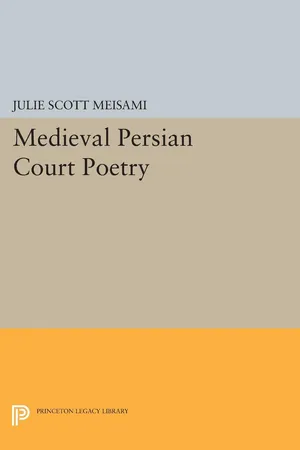
- 362 pages
- English
- PDF
- Available on iOS & Android
Medieval Persian Court Poetry
About this book
Dr. Meisami discloses previously neglected stylistic qualities and ethical purposes in medieval Persian court poetry, and shows that court poets were also moral instructors who examined and celebrated the values they shared with their audiences. The book also takes into account the close relationship between Persian and Arabic court poetry.
Originally published in 1987.
The Princeton Legacy Library uses the latest print-on-demand technology to again make available previously out-of-print books from the distinguished backlist of Princeton University Press. These editions preserve the original texts of these important books while presenting them in durable paperback and hardcover editions. The goal of the Princeton Legacy Library is to vastly increase access to the rich scholarly heritage found in the thousands of books published by Princeton University Press since its founding in 1905.
Frequently asked questions
- Essential is ideal for learners and professionals who enjoy exploring a wide range of subjects. Access the Essential Library with 800,000+ trusted titles and best-sellers across business, personal growth, and the humanities. Includes unlimited reading time and Standard Read Aloud voice.
- Complete: Perfect for advanced learners and researchers needing full, unrestricted access. Unlock 1.4M+ books across hundreds of subjects, including academic and specialized titles. The Complete Plan also includes advanced features like Premium Read Aloud and Research Assistant.
Please note we cannot support devices running on iOS 13 and Android 7 or earlier. Learn more about using the app.
Information
Table of contents
- Cover
- Contents
- List of Illustrations
- Preface
- I. Poet and Court in Persia
- II. The Poetry of Praise: The Qasidah and Its Uses
- III. Romance: The Language of Experience
- IV. Romance: Character as Moral Emblem
- V. Romance as Mirror: Allegories of Kingship and Justice
- VI. Ghazal: The Ideals of Love
- VII. Conclusion: The Art of the Court Poet
- Bibliography
- Index